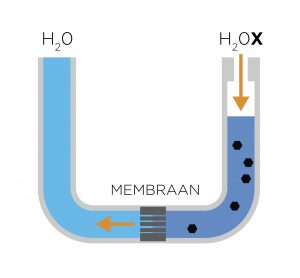Applied techniques
For the removal of salts with water supplies, generally, reverse osmosis water treatment demineralisation technique (RO) is used. This results in desalinated water, also known as denim water (demineralised water). As certain applications require a higher level of purity, sometimes even ultra-pure water, the RO water can be further treated using a second membrane step or electro-deionisation. The specialists at Lubron pick the treatment and choose which combination of water demineralisation technologies to use depending on the specific situation in order to deliver an optimal result.
The RO-technique is based on a natural phenomenon: the reverse osmosis water treatment process. With the use of mechanical pressure, the natural process is reversed (reverse osmosis). By applying force, the pure water starts flowing through a membrane. The solutes are left behind in the thickened water (concentrate) on the other side of the membrane. Depending on the type of the membrane, salts, organic compounds, and particulates, amongst other matter, can be left behind in the concentrate. Through the application of reverse osmosis, bacteria (including the Legionella bacteria), as well as viruses, can be prevented. The pure osmosis water can be used for numerous applications, for example, as irrigation water in the horticultural industry, as supply water for boiler and cooling systems, or as process water in the industrial sector.

Pre-treating osmosis water: Reverse osmosis water treatment
The thickened water which remains in the process (concentrate) is wastewater. In order to reduce the loss of water as much as possible, the feed water is pre-treated in some cases. For example, by softening the water, deposits are prevented in the membranes, therefore, pure osmosis water with a highest possible efficiency is produced and the amount of wasted water is reduced to a minimum.
Lubron designs and manufactures a wide range of RO plants. The available capacities vary from 160 litres/hour, for applications in the catering industry for example, up to 70,000 litres/hr for industrial applications. The larger Reverse Osmosis systems are always custom made.
Want to learn more?
Do you wish to know more about the described water demineralisation techniques or the application?
For various production applications, there are very high demands concerning the purity of the process water. By combining an RO system and a continuous electro-deionisation unit (EDI-unit), ultrapure water can be produced with a conductivity of up to about 0.06 mS/cm (18 MΩ at 25 ° C). The developed EDI system makes use of ion-selective membranes and the special ion exchange resin through which continuously pure water can be produced. No chemicals are used in the EDI technology.
Depending on the customer’s requirements, ultrapure water can be produced by various equipment models with different options. The Lubron EDI units range from a capacity of 100 litres/hour up to 24,000 litres/hour.
Want to learn more about industrial water demineralistion?
Do you wish to know more about the described techniques or the application?